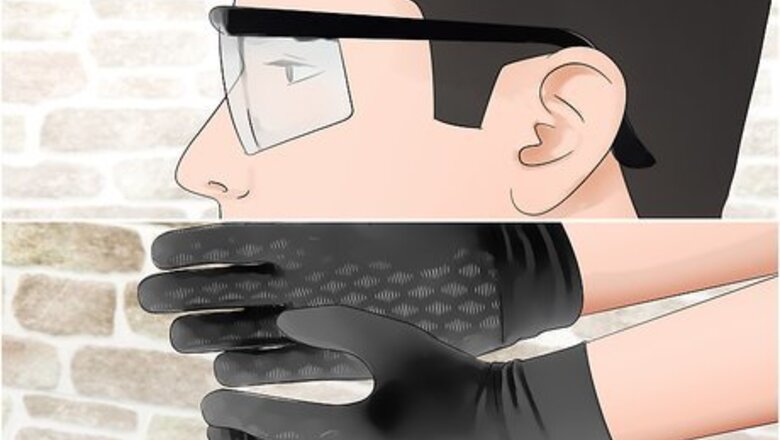
views
Disconnecting Your Car Battery Safely

Put on rubber gloves and safety goggles. Car batteries contain corrosive acid, which can irritate your skin and eyes. Before you start, put on a pair of heavy-duty work gloves made of rubber, nitrile, or neoprene. These will also help protect you from possible electric shock. Wear goggles that can protect your eyes from splashes or sparks as you work with the battery and cables. It’s also a good idea to wear clothing that covers your skin well, such as a long-sleeved shirt and long pants. Wear old clothes, since you’ll probably get greasy and dirty during the cleaning process.

Park your car in a well-ventilated area. When you work on a car battery, it’s important to do so outside or in a well-ventilated carport. Car batteries release hydrogen gas, which can cause an explosion if it comes into contact with a spark in an enclosed space. Never smoke while working on a car battery. Make sure the ignition is off, since having your car on can also increase the risk of sparks or explosions.
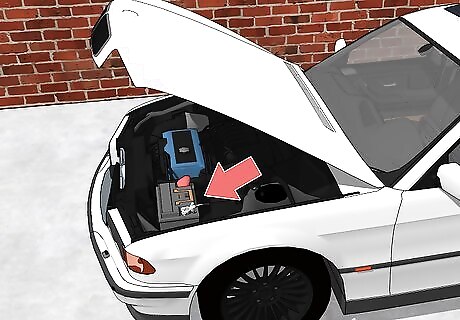
Open the hood of the car to access the battery. Open the driver’s side door of your car and find the hood latch or button. It may be located on or under the dashboard of your car. Pull the latch or press the button to pop the hood. Use the metal bar located inside the engine compartment to prop open your hood. Car batteries are typically easy to spot. They are rectangular boxes, often black, and usually with a red cap over one of the terminals. Many of them feature prominent yellow or white warning labels. While most car batteries are located under the hood, some models have them in other locations, such as in the trunk or under the back seat. If you can’t find your battery easily, consult the owner’s manual for your car. It's a good idea to let your vehicle cool down before you do this—if the engine's been running recently, you could burn yourself if you touch something hot. Also, if the battery is hot, there could be a buildup of gas, and that could potentially cause an explosion.
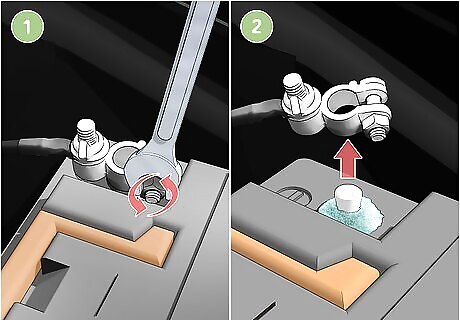
Disconnect the negative battery terminal. Locate the negative terminal on your battery, which typically has a black cap and a “-” or “NEG” written on it. Lift the plastic cap to expose the terminal. Use a wrench to loosen the nut on the cable clamp and a terminal spreader to open up the cable terminals, if necessary. Terminal spreaders are particularly helpful for overly tightened or stubborn terminal clamps. If there’s a lot of corrosive buildup, it might take some effort to work the cable connecter loose after you loosen the bolt. It can be helpful to pry it loose with a flathead screwdriver or prying tool. Always disconnect the negative cable, or ground clamp, first. This will prevent a dangerous short circuit.Warning: To prevent shocks and sparks, never leave your tools sitting on top of the battery.

Unhook the positive battery terminal. Next, move on to the positive terminal, which usually has a red cap and is labeled “+” or “POS.” Lift up the cap and then use your wrench to loosen the positive cable clamp. Move the disconnected cable terminals out of the way so they won’t touch the battery posts while you work.
Removing Car Battery Corrosion with Baking Soda
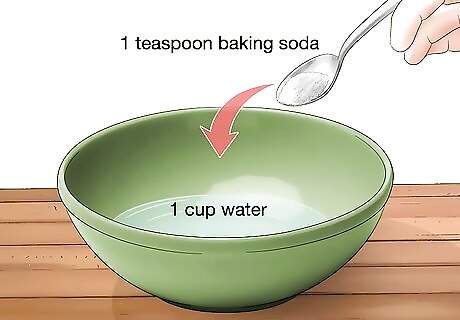
Mix 1 cup (240 mL) of water with 1 teaspoon (4.6 g) of baking soda. Pour the baking soda into lukewarm or cold water and mix them together thoroughly. This mixture will dissolve corrosion on the battery posts and cable terminals and also help neutralize any acid. You can also purchase commercial battery cleaners for this purpose. These typically come in the form of a spray-on foam. Look for them in a local auto parts store or in the automotive section of a department store. Alternatively, you can clean off the corrosion by pouring a small amount of cola over it!
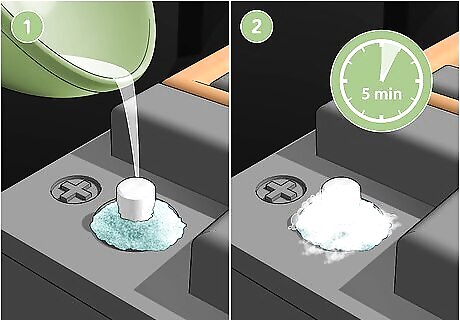
Pour half of your baking soda solution over the battery posts. When you’ve poured about half the mixture onto the posts, set the rest aside so you can use it to clean the terminals. If there’s a lot of corrosive buildup, let the mixture sit for at least 5 minutes before you try to scrub it off. Some automotive experts recommend dipping a brush into the baking soda mixture and using that to scrub the battery, rather than pouring the mixture directly onto the battery. Alternatively, you can remove the battery before cleaning it. This will allow you to clean up any corrosion that’s gotten onto other parts of the battery or into the battery box. You can also take this opportunity to inspect your battery for signs of damage, such as cracks or bulges in the casing.
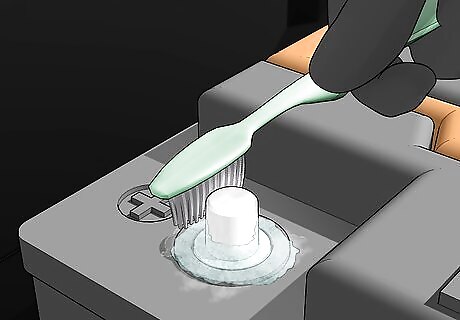
Scrub the battery posts with a toothbrush. Take an old toothbrush or a battery post and terminal brush and scrub the posts to clean off the corrosion. If the corrosion is fairly light, the baking soda solution may do most of the work for you, in which case, you won’t need to do much scrubbing. You can also use a wire brush to clean off the residue.
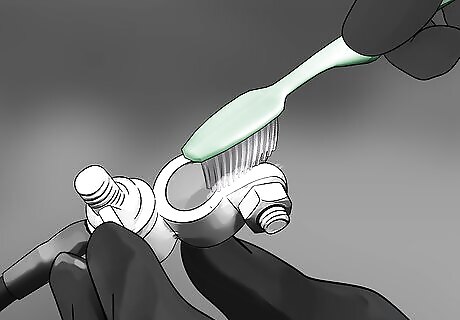
Use the rest of the solution to wash the cable terminals. If there’s corrosive buildup on the terminal clamps, pour the remaining baking soda solution over them. Use your toothbrush or a terminal brush to scrub away any residue that remains. Focus on the parts of the terminals that make direct contact with the battery posts.
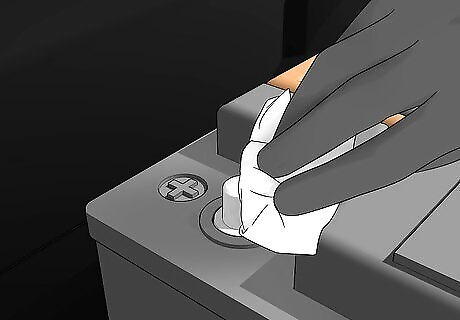
Wipe the posts and terminals dry with a clean rag. Take a clean shop rag and carefully wipe the battery posts and cable terminals to get rid of any remaining moisture or residue. If there’s a lot of debris, you can rinse the terminals and posts first with cool water from a hose or spray bottle. Make sure the terminals and posts are completely dry before you attempt to reconnect your battery. You’re not likely to get a severe electric shock from handling a wet car battery, but it’s best to use caution.
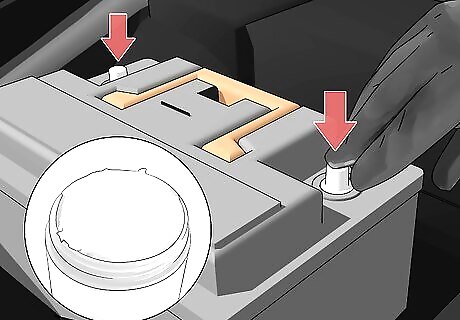
Apply petroleum jelly to the posts to prevent corrosion. Before you reconnect the battery terminals, rub a generous amount of petroleum jelly on each post. This will help prevent corrosion from forming on the posts and terminals again. You can get petroleum jelly at most drug stores.
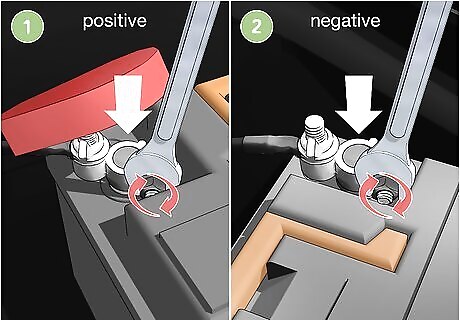
Reconnect the battery terminals, positive first. Put the positive terminal back on the positive post and use a wrench to tighten it in place. Next, do the same with the negative terminal. When you’re done, start your ignition to make sure the car will start and run properly. Make sure that you’ve removed all tools and cleaning supplies from the area around the battery before you close the hood.
Cleaning Corrosion on Alkaline Battery Contacts

Put on rubber gloves and safety goggles. While the “acid” in alkaline batteries is not actually acidic, it’s still corrosive. Protect your skin and eyes by putting on household gloves (such as nitrile or rubber cleaning gloves) and safety glasses or goggles before you start working. It’s also a good idea to protect your workspace by spreading out some newspapers or a plastic tablecloth.
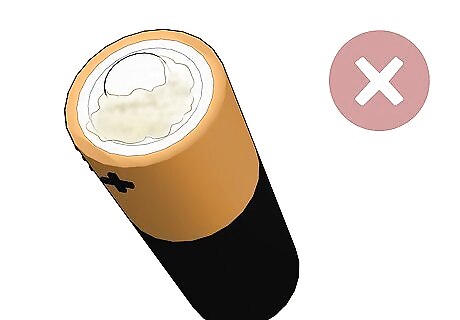
Dispose of the corroded battery. Once an alkaline battery starts to leak, it’s not good anymore. Depending on where you live, you may be able to throw the batteries away in your regular trash, or you may need to take them to a hazardous waste disposal facility. Call your local sanitation department to find out what to do with the batteries. Tip: To prevent the spread of caustic battery fluid, you may wish to use vinegar or lemon juice to clean any corrosion off the batteries themselves before throwing them away. If you live in the U.S., you can use the Earth911 Recycling Locator to find facilities near you that will accept alkaline batteries for recycling.
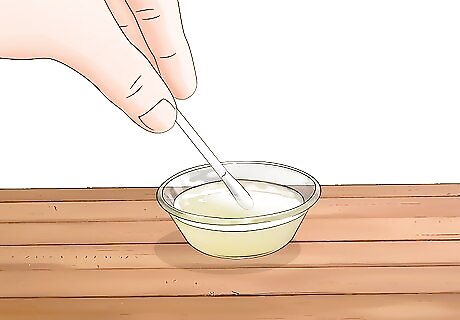
Dip a cotton swab in white vinegar or lemon juice. Unlike a car battery, alkaline batteries are filled with an alkaline, or basic, fluid. You’ll need a slightly acidic cleaning agent to neutralize the fluid and clean up the corrosion. Pour a little white vinegar or baking soda into a glass or plastic bowl, then dip a cotton swab in it. You can also use a small toothbrush. Take care not to oversaturate the swab so that you don’t get liquid inside the electrical components of your device. It should be damp but not dripping wet. You can always squeeze the swab to remove any excess.

Wipe the battery compartment and contacts with the swab. Take the cotton swab dipped in vinegar or lemon juice and rub it around inside the battery compartment wherever you see corrosion, especially on the battery contacts. This will start the process of dissolving and neutralizing the corrosion. Wipe the contacts dry with a clean paper towel when you’re done. Make sure to get inside the springs.
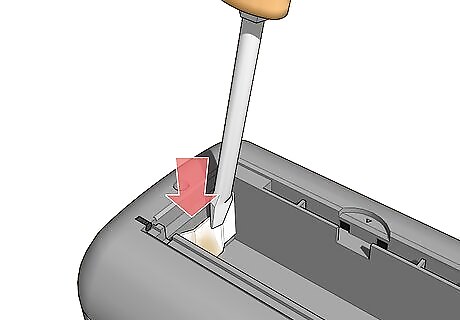
Scrape away any remaining residue with a metal tool. Use a small blade or flathead screwdriver to scrape off any stubborn corrosion that remains after wiping down the battery contacts. You can also use a fiberglass pen brush. Do this lightly so you don’t scratch up the contacts too much!
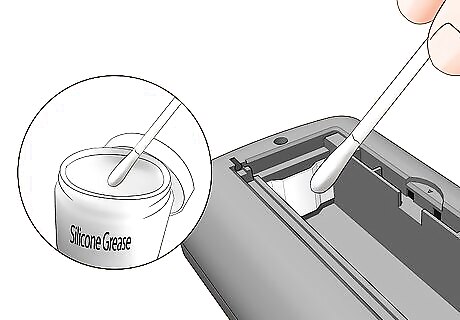
Coat the contacts with silicone grease to prevent tarnishing. When you’ve scraped away as much of the corrosion as possible, use a cotton swab to apply a light coating of silicone grease to the contacts. You can also use petroleum jelly. This will prevent future tarnishing and improve the connection between the contact and the battery. Look for silicone grease in your local hardware store. You can also get petroleum jelly in most drug stores.

Turn your device on to make sure it works. Put fresh batteries into your device and close the compartment, then turn it on. If it doesn’t work, you may need to do more cleanup or replace your device. If the battery terminals are too badly corroded to save, you may be able to replace them with new ones. You can buy replacement terminals online or from an electronics store, or scavenge some from another electronic device.
















Comments
0 comment